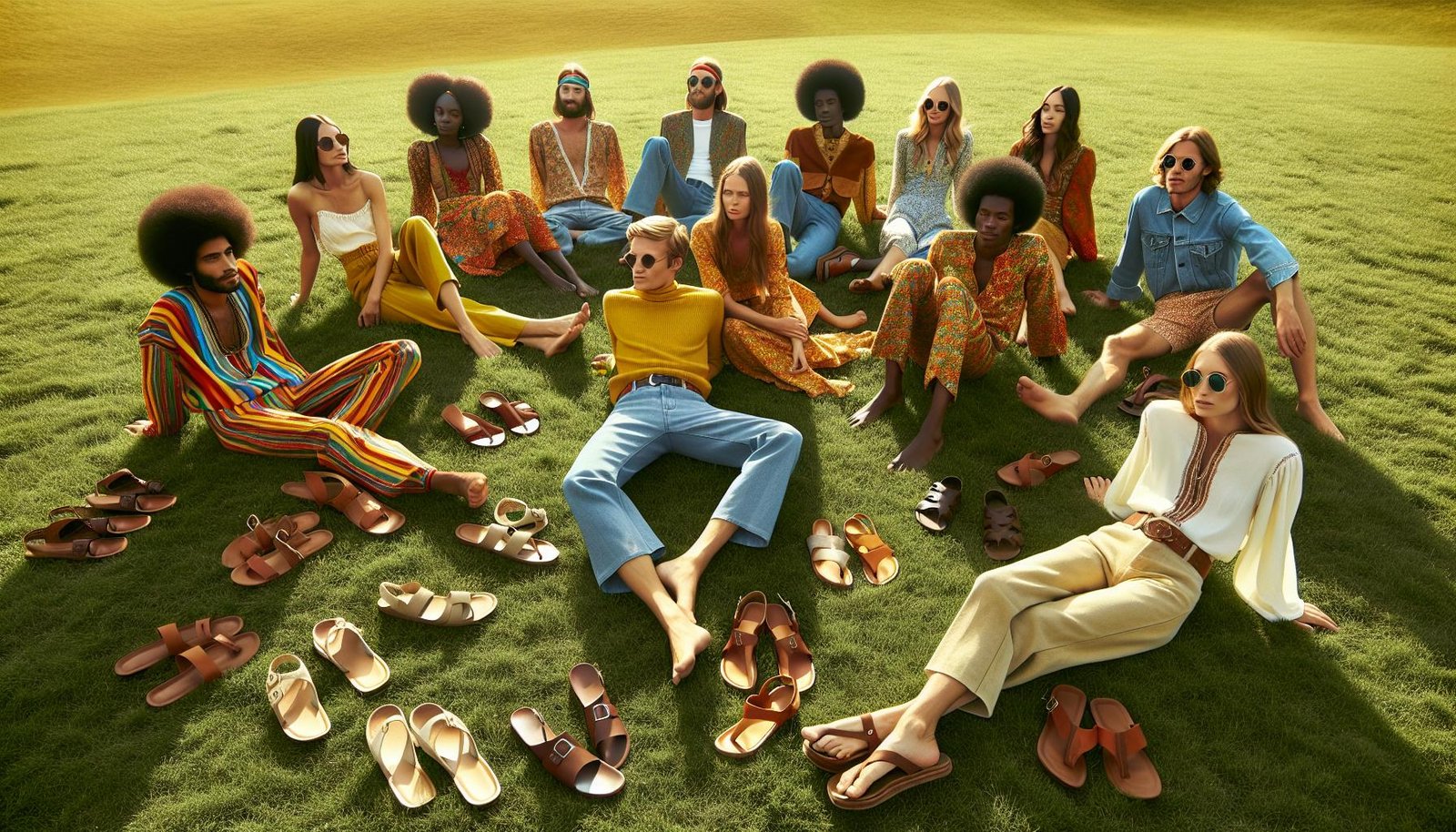What Shoes Did Hippies Wear? A Journey Through 60s and 70s Footwear Trends
The 1960s and 70s were a time of cultural revolution, and the hippie movement was at its heart. Hippies embraced a lifestyle that rejected mainstream norms, and their fashion choices reflected this ethos. Among the iconic elements of their wardrobe were the shoes they wore, which symbolized their values and the era’s spirit.
Footwear for hippies wasn’t just about comfort; it was a statement. From simple sandals to colorful moccasins, their choices were often handmade and eco-friendly. These shoes connected them to the earth and each other, embodying the movement’s ideals of peace, love, and harmony. As we delve into the types of shoes hippies favored, we’ll uncover how these choices were more than just fashion—they were a form of expression.
Key Takeaways
- Cultural Significance: Hippie footwear in the 1960s and 70s symbolized cultural rebellion, environmental consciousness, and a rejection of consumerism, reflecting broader social movements of the era.
- Types of Shoes: Popular hippie shoes included simple sandals, Birkenstocks, Earth Shoes, and handcrafted moccasins, often made from eco-friendly materials like leather, hemp, and rubber.
- Design and Symbolism: Footwear designs were simple yet unique, featuring elements like beads, fringe, and embroidery. These choices conveyed a connection to nature, individual expression, and health consciousness.
- Impact on Modern Fashion: Elements of hippie footwear, such as natural materials and minimalist designs, have influenced contemporary fashion, including high-end runway shows and popular eco-friendly brands like TOMS and Allbirds.
Historical Context of Hippie Fashion
The 1960s and 1970s were pivotal decades that reshaped cultural and social landscapes. Youth movements in these years embraced a counterculture ethos, challenging established norms and championing individuality. Hippie fashion, influenced by these dynamics, reflected an anti-establishment sentiment. Footwear choices exemplified this rebellion. Simple sandals and moccasins, often handmade and eco-friendly, were preferred for their connection to nature. These styles also symbolized a rejection of consumerism, prevalent during the era.
Cultural and Social Movements Impacting Fashion
Multiple social movements of the 1960s and 1970s deeply impacted fashion. The Civil Rights Movement emphasized equality and freedom, which translated into unrestrictive and comfortable clothing choices. The Peace Movement, advocating for an end to the Vietnam War, brought about styles that embodied peace and love. Footwear became a crucial part of this expression. Iconic styles from this period included peace-themed moccasins and ethnic-inspired sandals. Women’s Liberation and environmental activism further influenced hippie fashion. Shoes often featured natural, sustainable materials, aligning with eco-conscious principles. These cultural shifts made footwear a canvas for expressing broader ideological values.
Essential Shoe Styles in Hippie Culture

Sandals and Their Variants
Sandals featured prominently in hippie footwear. Made from natural materials like leather, hemp, or rubber, they embodied simplicity and eco-friendliness. Popular types included flat sandals, gladiator sandals, and thongs. The classic Birkenstock became synonymous with comfort and practical design, often chosen for its orthopedic benefits. Many preferred hand-made versions, adding unique designs like beads, colors, or woven patterns to reflect individuality. In the warmer months, sandals combined comfort with the free-spirited ethos of the hippie movement.
Earth Shoes: Embracing Nature and Comfort
Earth Shoes emerged as another staple in hippie fashion. Designed by Anne Kalso, these shoes gained popularity for their “negative heel” technology, where the heel sat lower than the toes. This design aimed to improve posture and provide better alignment, promoting natural movement. Often constructed using biodegradable or sustainable resources, Earth Shoes aligned with the era’s environmental consciousness. Their utilitarian style appealed to those looking for practical yet non-conformist footwear options. The rise of Earth Shoes highlighted the movement’s broader commitment to health, well-being, and ecological responsibility.
Distinctive Features of Hippie Shoes

Material Choices and Design
Hippie shoes often featured natural materials. Leather, hemp, and rubber were common choices for their eco-friendly properties. Sandals, a staple in hippie footwear, showcased these materials. Leather provided durability, while hemp offered a sustainable option. Rubber soles ensured comfort during long walks.
Designs were simple yet unique. Flat sandals and gladiator styles were prevalent. Birkenstocks stood out with orthopedic benefits, catering to the era’s health consciousness. Handmade elements added individuality. Beads, fringe, and embroidery adorned many shoes, reflecting the wearer’s personality and creativity.
Symbolism in Footwear
Footwear in the hippie movement symbolized more than style. Shoes expressed a rejection of consumerism. By choosing eco-friendly materials and sustainable designs, hippies demonstrated their connection to nature.
Hippie shoes also signified freedom. Simple designs and comfortable fits allowed for effortless movement. Earth Shoes, with “negative heel” technology, illustrated this commitment to health and physical well-being. Footwear choices often communicated a broader social message, aligning with the movement’s principles of peace, love, and environmental respect.
How Hippie Footwear Influenced Modern Shoes

From Counterculture to Runway
Hippie footwear, initially part of a counterculture movement, has significantly impacted fashion, including high-end runway shows. Designers have integrated elements like the simple aesthetic and natural materials into contemporary collections. Brands such as Gucci and Balenciaga have adopted sandal designs reminiscent of the ’60s and ’70s. Fashion trends often include flat sandals, gladiators, and open-toe shoes, reflecting the minimalist and eco-conscious aspects of hippie style.
Eco-Friendly Footwear Trends
Modern eco-friendly footwear trends owe much to hippie influences. The use of sustainable materials like hemp, recycled rubber, and vegan leather can be directly traced back to the environmentally-conscious choices of the 1960s and 70s. Companies like TOMS and Allbirds now prioritize sustainability, showing the lasting impact of hippie principles on today’s market. Eco-friendly practices include reducing carbon footprints, embracing minimalism, and promoting ethical labor practices, mirroring the hippie ethos of harmony with nature and social responsibility.

Hippie footwear from the ’60s and ’70s wasn’t just about fashion; it embodied a lifestyle that valued simplicity, nature, and social responsibility. The influence of eco-friendly sandals and comfort-focused designs is evident in today’s high-end fashion and sustainable footwear brands. Modern designers and companies continue to draw inspiration from the hippie ethos, proving that the movement’s impact on style and values endures. As contemporary fashion embraces sustainability and minimalist designs, the legacy of hippie shoes remains a testament to the enduring appeal of harmony with nature and mindful living.
Frequently Asked Questions
What types of materials were commonly used in hippie footwear?
Hippie footwear often featured eco-friendly materials like leather and hemp, which symbolized simplicity and environmental awareness.
Which shoe brands were popular during the hippie movement?
Brands like Birkenstock and Earth Shoes were popular for their unique designs focused on comfort and posture.
How did hippie footwear reflect the values of the movement?
The footwear choices rejected consumerism and emphasized nature and well-being, aligning with the hippie ethos.
How has hippie footwear influenced modern fashion?
Modern fashion incorporates elements like natural materials and minimalist designs from hippie footwear into high-end collections by brands such as Gucci and Balenciaga.











